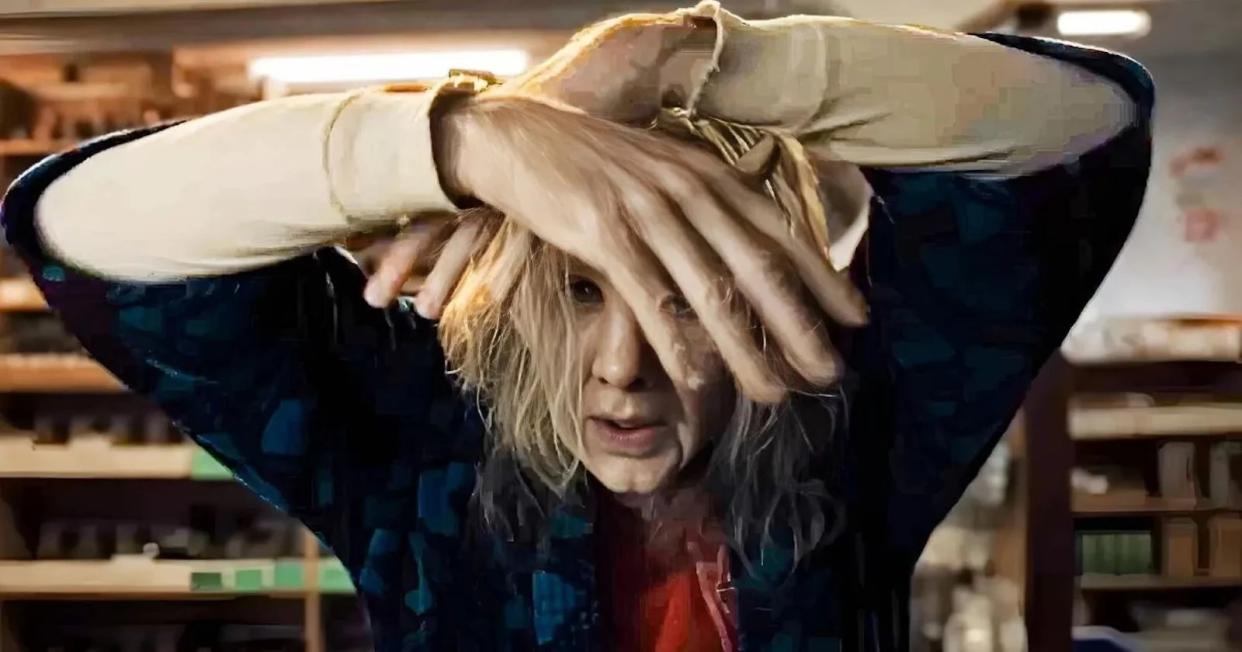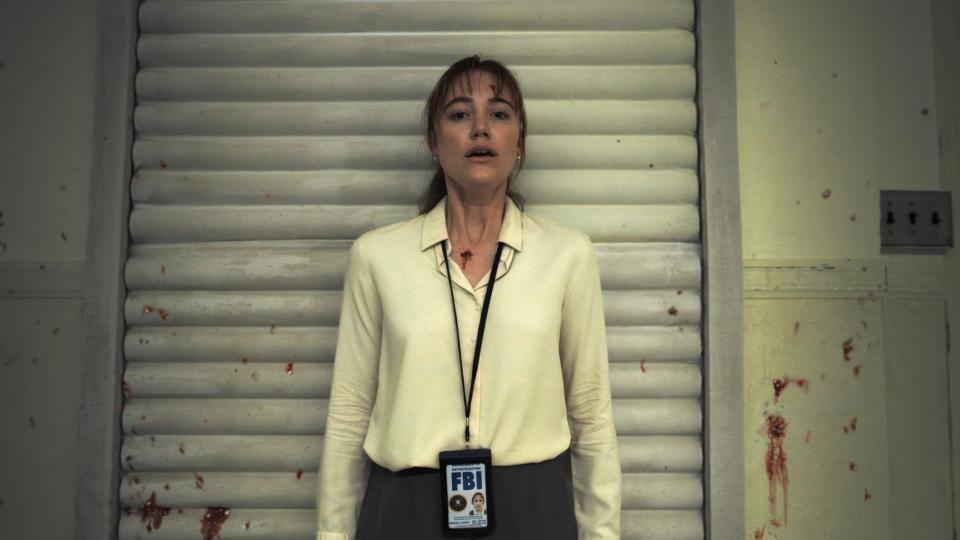Nicolas Cage’s Max Schreck Moment: Behind the Backstory and Look of His ‘Longlegs’ Serial Killer

In “Longlegs,” the audience is purposely kept from seeing Nicolas Cage as the titular serial killer. In the opening sequence, when a young Lee Harker (Lauren Acala) comes face to face with Longlegs, he is too tall for the frame, visible only from the chest down.
“We don’t need to see him, that’s the oldest trick in the book, the audience’s imagination will provide better than you can,” writer/director Osgood Perkins told IndieWire. “The idea ultimately was to say, ‘Hey, this guy is obviously something you don’t want to see.”
More from IndieWire
It’s a trick that only works if the payoff delivers. The buildup to the sight of Cage as the disfigured, puffy Longlegs needs to not only live up to the audience’s imagination, but the movie’s success pivots on the reveal advancing the story. IndieWire talked to Perkins and makeup department head Felix Fox about creating the look of Longlegs, the character’s backstory (which is visually implied but never made explicit in the film), their close collaboration with Cage (a devoted cinephile with a strong sense of his character’s horror movie roots), what Perkins wanted from the moment he finally reveals his killer, and how Fox ultimately executed the look.
Longlegs’ Face
“The idea was that he’d been busted by shitty plastic surgery,” said Perkins. “And that’s about the mask, it’s the masked killer, it’s a genre imperative, whether it’s Michael Myers [‘Halloween’] or Jason [‘Friday the 13th’], or ‘Black Phone.’”

In developing the initial concept, special makeup effects artist Harlow MacFarlane imagined the state of 1970s and ‘80s elective plastic surgery in rural Oregon, where the film is set. In creating the initial look, he worked off the premise of one mall doctor hatchet job leading to the next, compounding rather than fixing the previous mistakes, the skin becoming damaged and puffy.
“If you ever watched episodes of ‘Botched,’ there’s no end to striving for perfection in your whole look, and that’s what we were trying to do,” said Fox. “The balance between tightening the face and also filling the face is sort of typical in plastic surgery. First you tighten, and then we have to fill it to make it more youthful. And there’s that dance back and forth, often resulting in puffy, sort of disfigured skin.”
To get the plump, damaged skin, Fox applied silicone-encapsulated prosthetic makeup in seven pieces to Cage’s face: left and right cheeks, upper and lower lips, forehead, chin, and nose. All in, the application of Cage’s hair and makeup took two and a half hours every morning.
An Androgynous Ex-Glam Rocker

Longlegs big hair was a key part of his backstory as an ex-glam rocker, which helped motivate the character’s heavy makeup, superficial fixation on trying to stay young, and the sense that Longlegs has carefully curated his look.
“It’s very much glam rock inspired. If you catch a full glimpse on screen, he’s got his lizard white leather cowboy boots,” said Fox. “It was quite fantastic when you got to see the whole thing; he’s a taller man, so his whole presence stomping around in these white boots with the white jacket, it was pretty impressive looking.”
Longlegs’ androgynous look is another key part of his glam rock persona. In an interview between Cage and Perkins for Fangoria, it is clear this was particularly important to the actor, who said, “I wanted Longlegs to be very androgynous. I was thinking about the androgynous prophet in Fellini’s ‘Juliet of the Spirits,’ and the prophet was going, ‘Do you think I’m beautiful?’ You told me to sort of plump my hair. So I did that, and then I started saying to Maika [Monroe, the lead of ‘Longlegs’], ‘Do you find me beautiful?’”
White Makeup & Bob Dylan
The role and application of Longlegs’ heavy, whitish makeup are an aspect of Longlegs’ glam rock backstory, but Perkins was inspired by a decidedly non-glam rocker when writing the script.
“The pale makeup is Bob Dylan,” said Perkins. “Bob Dylan’s my god, and so I’m always looking for ways to use Bob’s stuff, and that white makeup that he uses on the ‘Rolling Thunder Revue’ tour is this weird sort of performative thing. It’s like, ‘I’m here to perform for you, and I put on this white makeup, so I’m more visible to you in a way, but at the same time, I’m also more invisible,’ which I find fascinating.”

According to Fox, the white powder makeup is also how Longlegs conceals his botched plastic surgery and tries to make himself look pretty. Fox told IndieWire that getting the makeup right was a continually evolving process.
“[The white makeup] was huge, and that actually changed quite a bit in the makeup test,” said Fox. “Originally, we had done almost a sort of geisha hard line on the jaw as if he was using a pancake type makeup, which is more theatrical. And then as it played out, it started to look a little bit too much like a caricature.”
Fox would pull back and use a more powdered look, but this issue of Cage’s Longlegs becoming too much of a caricature carried into all areas of the character’s look.
The Reveal: Longlegs’ Humanity
The issue of handling the scarring of the skin was a similar balancing act. According to Fox, Longlegs’ initial backstory involved him being burned, and there’d have been additional scarring from the repeated botched surgeries.
“That always is a very tricky thing because there’s another line you can cross,” said Fox. “You’re into third-degree scarring, which is monstrous. It was that fine line of making it look like there was some damage, [touching on] that mysterious backstory, but how far do we go?”
It was important to Perkins that Longlegs is seen as a human, not a monster, and the audience can connect with his humanity.
“A guy whose face is bad plastic surgery and white face makeup, that felt really scary to me, and it also felt sad to me, which was important,” explained Perkins. “He’s not the Hydra [the many-headed snake monster from Greek mythology referenced in the film’s opening text, a lyric by the band T-Rex], he’s a person who was presumably doing something else in his life before the devil tapped him on his shoulder and said, ’It’s time, you’re now my secretary.'”
Perkins saw Longlegs as someone who didn’t seek to do evil; he doesn’t enjoy murder and mayhem but is compelled to do it. This is why, after withholding Longlegs’ appearance for so long, his full frontal appearance at the bus stop is presented as matter-of-factly as possible. After making the audience anticipate a hideous monster who is liable to jump out at any moment, Perkins wanted us to see his serial killer for the first time through a different lens: Freely giving himself up (in a nod to “Se7en”) at a bus stop (a nod to Gus Van Sant and “My Private Idaho”).
“He’s as shabby and shitty and ugly and pathetic as possible, and that was just meant to make him a human being, just a person, not a monster,” said Perkins of the scene.
Cage Reaches for Movie Immortality

In the Fangoria interview with Perkins, Cage made it clear he saw it as his responsibility to bring a vulnerability to the character. Lon Chaney, the “Man of a Thousand Faces” (the title of both a 1957 biopic and 2000 documentary of the famed actor), who played characters like Quasimodo in “The Hunchback of Notre Dame” (1923) and the Phantom in “The Phantom of the Opera” (1925), was a key touch point for Cage.
“What I liked about Lon Chaney’s monsters is that they always had a heart, and I always felt bad for them. And for me, that was a way of saying, ‘I want to make Longlegs about my mom.’ Yes, I turned my mother into a serial killer; you can do that when you’re feeling artistic,” said Cage, who modeled his Dracula character in “Renfield” after his father.
According to Perkins, Cage very much saw Longlegs as his chance to play a disfigured Lon Chaney-like role, which presented another question for the “Longlegs” team to interrogate at every stage of the process: How much should the iconic star disappear into the disguise of Longlegs? According to the film’s press notes, early on,f MacFarlane was hesitant to go full “Phantom of the Opera” with an upturned nose like Chaney, concerned it would play as over-the-top. According to Fox, who was tasked with executing MacFarlane and Amazing Apes’ (an FX company specializing in character creation) concept designs, it was a back-and-forth discussion that ran through the makeup tests.
“The nose was a collaboration for sure. Nic had some ideas; originally, there was a finer tip nose that brought out a little bit more of him, and then he felt pretty strongly, and so did Oz, and all of us really in the end, that we wanted to disguise him a little bit more,” said Fox. “It was ultimately the right decision to go with that, that heavier pixie type [nose].”
Perkins said they never reached for full-on disguise, never crossing the line into wanting Cage to 100 percent disappear in Longlegs (he estimated it was more 90 percent), but reported he was proud when someone who wandered into the color grade session guessed that Meryl Streep was playing Longlegs. Of course, once Cage is seen moving and heard talking the iconic actor is recognizable under the makeup and hair.

According to Perkins, the decision was ultimately guided by two movie nerds who reached for the horror movie pantheon.
“Nic is a really hardcore fan of motion pictures, he knows every movie. If I recommend a movie to him at 10 o’clock in the morning, he calls me at noon and he’s watched it. He knows every performance, he knows every line,” said Perkins. “And so when we start talking about makeup, we get into Lon Chaney, we get into Universal Horror Monsters, we get really granular. He worships the classics like I do. So when it got into this mode of: We could really do something fucking movie crazy. We could go full [Boris] Karloff with this, we could go full Lon Chaney, full Freddy Krueger, something that’s so filmic, something so, ‘This is what the movie art is,’ why wouldn’t we pull every lever that we have? It really just grew out of wanting to do something that felt like we were rubbing against the classics.”
Perkins relayed a recent exchange he had with Cage. In response to a review in which Cage’s Longlegs was compared to Max Schreck’s iconic turn as the original movie vampire in “Nosferatu” (1922), the actor texted the director.
“Cage texted me, he’s like, ‘That’s it.’ He’s like, ‘Now I’m done, that’s the top, to be mentioned in the same sentence as that, we’re done here.’ I think it really is that,” said Perkins. “We love movies, we love the fact that we get to make them. So when you’re presented with an opportunity… and you have Nicolas Cage wanting to rub up against Max Schreck, you’re fully committed.”
Best of IndieWire
The 30 Best Nude Scenes in Film, from 'Shortbus' to 'Blue Velvet' to 'No Hard Feelings'
The 15 Best Thrillers Streaming on Netflix in July, from 'Fair Play' to 'Emily the Criminal'
Sign up for Indiewire's Newsletter. For the latest news, follow us on Facebook, Twitter, and Instagram.
